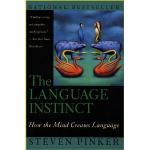|
This section contains 473 words (approx. 2 pages at 400 words per page) |

|
Chapter 4: How Language Works Summary and Analysis
Chapter 4: How Language Works
Language conveys news. It is important for a person to understand who did what to whom, as shown in the oft-used example that "dog bites man" is not news but "man bites" dog is news.
These principles are related to two "tricks." The first, articulated by Ferdinand de Saussure is the arbitrariness of the sign, which discusses the conventional combination of sound and meaning. The second trick is shown with an example from Wilhelm Humboldt, who says that language "makes infinite use of finite media." Chap. 4, p. 84
Pinker goes on to explain that people use a code to translate the order of words. This code is known as generative grammar, which is different from stylistic grammar and pedagogical grammar.
Pinker defines the main principle of grammar: "The principle underlying grammar is...
(read more from the Chapter 4: How Language Works Summary)
|
This section contains 473 words (approx. 2 pages at 400 words per page) |

|




